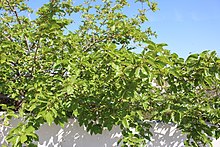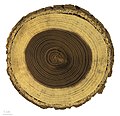Morus alba
| White mulberry | |
|---|---|

| |
| Scientific classification | |
| Kingdom: | Plantae |
| Clade: | Tracheophytes |
| Clade: | Angiosperms |
| Clade: | Eudicots |
| Clade: | Rosids |
| Order: | Rosales |
| Family: | Moraceae |
| Genus: | Morus |
| Species: | M. alba
|
| Binomial name | |
| Morus alba L. 1753
| |
| Subspecies | |
| |
| Synonyms[1] | |
| |
Morus alba, known as white mulberry, common mulberry and silkworm mulberry,[2] is a fast-growing, small to medium-sized mulberry tree which grows to 10–20 m (33–66 ft) tall. It is generally a short-lived tree with a lifespan comparable to that of humans, although there are some specimens known to be more than 250 years old.[3] The species is native to China and India[4] and is widely cultivated and naturalized elsewhere (including United States, Mexico, Australia, Kyrgyzstan, Argentina, Turkey, Iran, Iraq, and many others).[5][6][7][8][9][10]
The white mulberry is widely cultivated to feed the silkworms employed in the commercial production of silk. It is also notable for the rapid release of its pollen, which is launched at greater than half the speed of sound.[11] Its berries are edible when ripe.
Description
[edit]

On young, vigorous shoots, the leaves may be up to 30 cm (12 in) long, and deeply and intricately lobed, with the lobes rounded. On older trees, the leaves are generally 5–15 cm (2.0–5.9 in) long, unlobed, cordate at the base and rounded to acuminate at the tip, and serrated on the margins. Generally, the trees are deciduous in temperate regions, but trees grown in tropical regions may be evergreen.[citation needed]
The flowers are single-sex catkins; male catkins are 2–3.5 cm (0.8–1.4 in) long, and female catkins 1–2 cm (0.4–0.8 in) long. Male and female flowers are usually found on separate trees although they may occur on the same tree.[12][13] The fruit is 1–1.5 cm (0.4–0.6 in) long. In the wild it is deep purple, but in many cultivated plants it varies from white to pink. It is sweet but bland, unlike the more intense flavor of the red mulberry and black mulberry. The seeds are widely dispersed in the droppings of birds that eat the fruit.[5][6][14]
The white mulberry is scientifically notable for the rapid plant movement involved in pollen release from its catkins. The stamens act as catapults, releasing stored elastic energy in just 25 μs. The resulting movement is approximately 380 miles per hour (610 km/h), about half the speed of sound, making it the fastest known movement in the plant kingdom.[11]
Taxonomy
[edit]Two varieties of Morus alba are recognized:[5]
- Morus alba var. alba
- Morus alba var. multicaulis
Cultivation
[edit]
Cultivation of white mulberry to nourish silkworms began more than 4,700 years ago in China and has since been introduced in other countries. The Ancient Greeks and Romans cultivated the mulberry for silkworms. At least as early as 220 AD, Emperor Elagabalus wore a silk robe.[15] It was introduced into other parts of Europe in the twelfth century and into Latin America after the Spanish conquest in the fifteenth century.[16] In 2002, 6,260 km2 of land were devoted to the species in China.[6]
It has been grown widely from the Indian subcontinent[6] west through Afghanistan and Iran to southern Europe for more than a thousand years for leaves to feed silkworms.[14]
More recently, it has become widely naturalized in disturbed areas such as roadsides and the edges of tree lots, along with urban areas in much of North America, where it hybridizes readily with the locally native red mulberry (Morus rubra). There is now serious concern for the long-term genetic viability of the red mulberry because of extensive hybridization in some areas.[17]
The species is now extensively planted and widely naturalized throughout the warm temperate world and in subarctic regions as well, and would survive in elevations as high as 4,000 metres (13,000 ft). They thrive in mildly acidic, well drained, sandy loam and clayey loam soils, though they can withstand poor soils as well.[16]
Toxicity
[edit]Tests on laboratory rats have not found mulberry extract to present significant toxicity.[18][19]
According to a coroner's report, Lori McClintock, wife of US politician Tom McClintock, died in December 2021 from dehydration due to gastroenteritis caused by "adverse effects of white mulberry leaf ingestion"; the leaf is used as a dietary supplement or herbal remedy for weight loss and diabetes.[20]
Uses
[edit]
White mulberry leaves are the preferred feedstock for silkworms, and are also cut for food for livestock (cattle, goats, etc.) in areas where dry seasons restrict the availability of ground vegetation.[citation needed]
The leaves are prepared as tea in Korea. The fruit are also eaten, often dried or made into wine.[6][14]
For landscaping, a fruitless mulberry was developed from a clone for use in the production of silk in the U.S. The industry never materialized, but the mulberry variety is now used as an ornamental tree where shade is desired without the fruit.[21]
White mulberry, Morus alba 'Pendula', is used as an ornamental plant.[22] It was planted at several grand stations built along the Lackawanna Railroad in New Jersey during the late 1800s and early 1900s. The species is a lawn tree across the desert cities of the southwestern United States, prized for its shade and also for its cylindrical berry clusters composed of sweet, purplish-white fruits.[23] The plant's pollen is problematic in some cities where it has been blamed for an increase in hay fever.[24][25][26]
Gallery
[edit]-
Morus alba - MHNT
-
Fruitless mulberry trees
-
Pennsylvania state champion Morus alba at Longwood Gardens.
-
Leaves and male flowers in the spring.
-
Leaf variation
-
Morus alba flowers in India
-
Flowers and leaves in Spain
-
Fruits in India
-
'Pendula' cultivar in Iran
-
A tree planted by Edmond James de Rothschild in 1922 in attempt to build silk industry in Israel
-
Mulberries fallen to the ground in peak season.
See also
[edit]- Blackberry, which has similar-looking fruit
- Mulberrofuran G
- Sericulture, silk farming
- Osage orange
References
[edit]- ^ "Morus alba L.". World Checklist of Selected Plant Families. Royal Botanic Gardens, Kew – via The Plant List. Note that this website has been superseded by World Flora Online
- ^ Morus alba L. by Weeds of Australia - Biosecurity Queensland Edition (Queensland Government)
- ^ "The thickest, tallest, and oldest white mulberry trees (Morus alba)".
- ^ Patel, Raman; Hazra, Taposhi; Rana, Rajendra Singh; Hazra, Manoshi; Bera, Subir; Khan, Mahasin Ali (2021). "First fossil record of mulberry from Asia". Review of Palaeobotany and Palynology. 292: 104459. Bibcode:2021RPaPa.29204459P. doi:10.1016/j.revpalbo.2021.104459. ISSN 0034-6667.
- ^ a b c Wu, Zhengyi; Zhou, Zhe-Kun; Gilbert, Michael G. "Morus alba". Flora of China. Vol. 5. Retrieved 27 June 2013 – via eFloras.org, Missouri Botanical Garden, St. Louis, MO & Harvard University Herbaria, Cambridge, MA.
- ^ a b c d e "Morus alba". Flora of China. 5: 23. Retrieved 26 August 2022.
- ^ Wunderlin, Richard P. (1997). "Morus alba". In Flora of North America Editorial Committee (ed.). Flora of North America North of Mexico (FNA). Vol. 3. New York and Oxford: Oxford University Press – via eFloras.org, Missouri Botanical Garden, St. Louis, MO & Harvard University Herbaria, Cambridge, MA.
- ^ "Morus alba". County-level distribution map from the North American Plant Atlas (NAPA). Biota of North America Program (BONAP). 2014.
- ^ Atlas of Living Australia, Morus alba L., White Mulberry[permanent dead link]
- ^ SEINet, Southwestern Biodiversity, Arizona chapter photos, description, distribution map
- ^ a b Taylor, Philip; Gwyneth Card; James House; Michael Dickinson; Richard Flagan (2006-03-01). "High-speed pollen release in the white mulberry tree, Morus alba L". Sexual Plant Reproduction. 19 (1): 19–24. doi:10.1007/s00497-005-0018-9. S2CID 39703983.
- ^ Schaffner, John H. 1919. The nature of the diecious condition in Morus alba and Salix amygdaloides. Ohio Journal of Science 18: 101-125.
- ^ Purdue University. Center for New Crops & Plant Products. NewCROP: Morus alba.
- ^ a b c Bean, W. J. (1978). Trees and Shrubs Hardy in the British Isles. John Murray ISBN 0-7195-2256-0.
- ^ Lyle, Katie Letcher (2010) [2004]. The Complete Guide to Edible Wild Plants, Mushrooms, Fruits, and Nuts: How to Find, Identify, and Cook Them (2nd ed.). Guilford, CN: FalconGuides. p. 103. ISBN 978-1-59921-887-8. OCLC 560560606.
- ^ a b White mulberry (Morus alba) by Feedipedia.org
- ^ Burgess, K.S., Morgan, M., Deverno, L., & Husband, B. C. (2005). Asymmetrical introgression between two Morus species (M. alba, M. rubra) that differ in abundance. Molec. Ecol. 14: 3471–3483.
- ^ Hong, Min; Lu, Min; Qian, Yimin; Wei, Liping; Zhang, Yaqun; Pan, Xueying; Li, Hua; Chen, Huaying; Tang, Naping (2021). "A 90-day Sub-chronic Oral Toxicity Assessment of Mulberry Extract in Sprague Dawley Rats". INQUIRY: The Journal of Health Care Organization, Provision, and Financing. 58. SAGE Publications. doi:10.1177/00469580211056044. ISSN 0046-9580. PMC 8613892. PMID 34812659.
- ^ Li, Yuzhe; Zhang, Xiaopeng; Liang, Chunlai; Hu, Jing; Yu, Zhou (2018). "Safety evaluation of mulberry leaf extract: Acute, subacute toxicity and genotoxicity studies". Regulatory Toxicology and Pharmacology. 95: 220–226. doi:10.1016/j.yrtph.2018.03.007. ISSN 0273-2300. PMID 29530616. S2CID 4859424.
- ^ Young, Samantha (August 24, 2022). "Congressman's wife died after taking herbal remedy marketed". NBC News. Kaiser Health News.
- ^ Howstuffworks.com
- ^ USDA, NRCS (n.d.). "Morus alba". The PLANTS Database (plants.usda.gov). Greensboro, North Carolina: National Plant Data Team.
- ^ Little, Elbert L. (1994) [1980]. The Audubon Society Field Guide to North American Trees: Western Region (Chanticleer Press ed.). Knopf. p. 424. ISBN 0394507614.
- ^ Pollen Library, White Mulberry (Morus alba)
- ^ Thermo Scientific,
- ^ University of Arizona Cooperative Extension, Yavapai County, Plants That May Cause Allergies in Yavapai County Archived 2016-06-16 at the Wayback Machine
External links
[edit]![]() Data related to Morus alba at Wikispecies
Data related to Morus alba at Wikispecies
- USDA Plants Profile for Morus alba white mulberry
- "Morus alba". Germplasm Resources Information Network. Agricultural Research Service, United States Department of Agriculture.
- Morton Arboretum: Diagnostic photos of white mulberry tree (acc. 380*82-1)
- Invasive.org: U.S. National Forest Service, Invasive Species Weed of the Week − Morus alba











